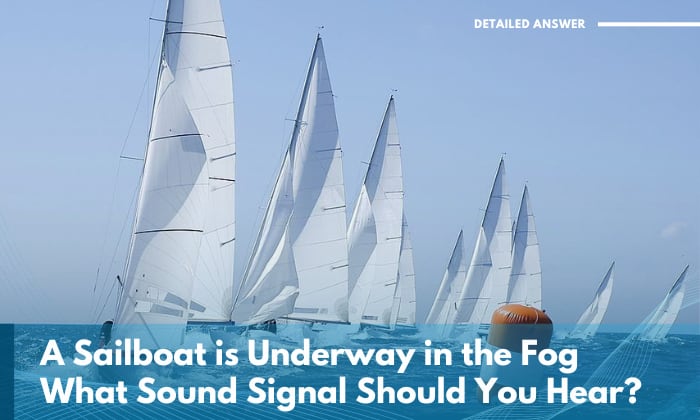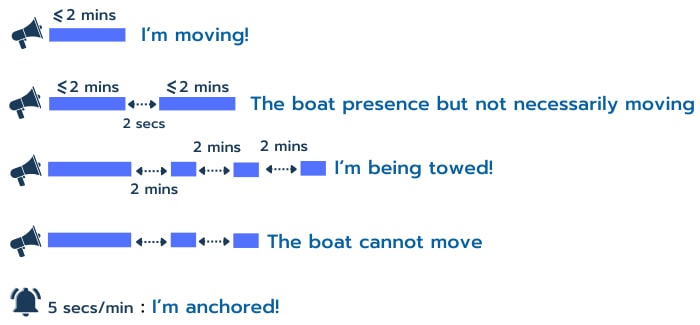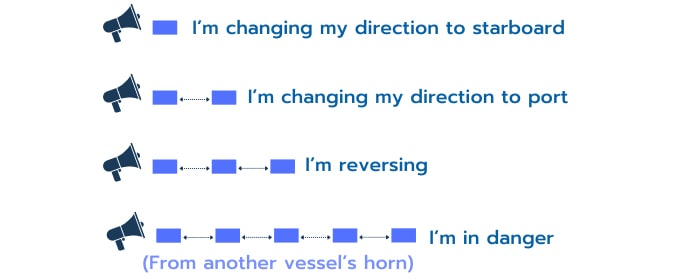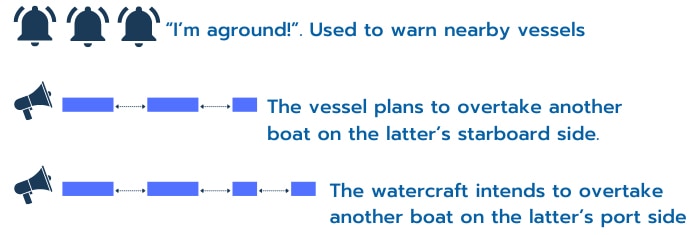Consider this scenario: You’re sailing along in open waters with minimal visibility (i.e. restricted view). Soon enough, your instincts start wondering “a sailboat is underway in the fog. What sound signal should you hear?”
Assuming the one captaining the vessel is familiar with boating in fog signals, he or she should:
- Sound one prolonged blast plus two short blasts every two minutes lasting from four up to six seconds. These should be produced in intervals of at most two minutes.
- If the sailboat is motor-driven, the captain should sound one prolonged blast every two minutes or with the same interval as above.
Table of Contents
What is Restricted View? Rules for Operating
It’s an instance when various factors limit your view or ability to be seen any time you’re out sailing. It can be due to natural factors like weather conditions that bring plenty of rain and fog. Other vessels and even structures, natural or artificial, can affect it, too.
Knowing what to do during restricted visibility environments only ensures your safety. It’s not just about knowing what to hear when a powerboat is underway in the fog, but being familiar with a whole lot of regulations as outlined in COLREGS (Collision Regulations).
COLREGS rules when operating in conditions of reduced visibility can be summed up as follows:
- Boats must always operate at an appropriate speed based on the present conditions and limited visibility.
- Once you’ve detected another watercraft by radar, the first instinct should always be to evade it without delay.
- When complying with navigation rules, vessel operators must always factor in, if not prioritize, the specific conditions brought about by restricted view.
- Motor-powered vessels must always be ready to perform the necessary maneuver to avoid collisions. That answers the question, “What immediate action should you take?” if your boat belongs to that category.
- Once you hear the horn signal of the other vessel or can’t avoid coming near the vessel forwards of the boat’s beam, the first course of action should always be to decrease speed up to the minimum allowable to keep the vessel on course.
- Alter course to starboard for vessels forward of the beam; the same applies to vessels abeam or abaft the beam on the port quarter. Change course to port for boats abeam or abaft the beam on the starboard quarter.
- Certain evading actions are discouraged, such as altering course to port for a boat “forwards of the beam”, except if the intent is to overtake. The same goes for maneuvers towards a boat “abeam or abaft the beam”.
- Unless you’ve ascertained that there’s no longer any risk of collision with another vessel, always exercise extreme caution.
How to Prepare for Fog While Boating
Besides learning horn signals for boats and standard procedures during limited visibility situations, it won’t hurt to be a few extra steps ahead to anticipate foggy conditions every time you take your boat out.
Here are a few strategies a lot of experienced skippers can attest to:
- Don’t be a speed demon as much as possible. Be open to stopping and anchoring anywhere and any time should the need arise (i.e. the fog gets too thick).
- Always check the weather forecast. Be mindful of how serious the possible fog conditions will be.
- Find the right crew to work with and instill in them the mindset that they should be ready to assist you during difficult and emergency situations. Having someone check how thick the fog is getting regularly is already a big help.
- Always inspect your boat’s safety equipment, especially the navigational lights and horns, before embarking. I can say the same for the electronics and emergency kits you bring along.
- When visibility is restricted due to fog, a GPS can be a literal godsend. Having a digital map of the immediate area and being able to know where your boat is currently, all available on a nifty screen, is hard to top.
It has definitely spared me from becoming my (usual) bundle of nerves if I find myself in extra-dense fog. Want proof? Here’s a video of Capt. Scott saying nice things about this helpful tool:
- Last but not least, always take the time to familiarize yourself with your boat. Know its capabilities and limitations, especially when making safety maneuvers during restricted-visibility conditions.
List of Sounds and Their Meanings
Besides the sailboat underway in fog signal mentioned here, you should also learn all the other sound signals that apply to restricted visibility:
- One prolonged blast every 2 minutes
This means, “I’m moving!” and is made by a motor-driven vessel underway and moving through the water.
- Two prolonged horn blasts in succession with 2-second intervals every 2 minutes
The boat is underway but not progressing through the water. It simply announces its presence but not necessarily moving.
- One long horn blast followed by three short ones every 2 minutes.
This means, “I’m being towed!” so you have to steer clear of the boat.
- One prolonged blast and two short ones.
The boat cannot move, whether due to circumstances beyond its control (such as broken engines) or the work it’s doing (e.g. mine clearance, servicing pipelines).
- Bell rings for five seconds every minute.
This means, “I’m anchored!”. Generally used to warn other boats that the vessel is not moving.
Common Sounds
Based on the pattern of the sound signals for boats as explained above, there are technically only two commonly-used sounds involved when warning other vessels: a short blast that typically lasts no more than a second and a long one that can last between 4 to 6 seconds.
Sounds to Communicate With Fellow Boaters
There are other boating sound signals that aren’t necessarily related to restricted visibility. These include the following:
- I’m changing my direction to starboard.
This is communicated with one short blast.
- I’m changing my direction to port.
Vessels emit two short blasts for this.
- I’m reversing.
You’ll hear three short blasts if the vessel is applying astern propulsion.
- I’m in danger.
When you hear 5 short blasts from another vessel’s horn, this typically connotes trouble. You can also use that sound pattern to say that you don’t understand or don’t agree with a vessel’s course of action.
Sounds to Make Your Location Known
- Three separate bell strokes before or after rapid ringing.
This means, “I’m aground!”. Used to warn nearby vessels.
- Two long whistle blasts followed by one short one
This means the vessel plans to overtake another boat on the latter’s starboard side.
- Two long whistle blasts followed by two short ones
This means the watercraft intends to overtake another boat on the latter’s port side.
Other signals
Besides sound signals, you can also use flags, flares, radio signals, hand signals, and emergency beacons to communicate with other boat operators. However, as is obvious from their purpose and design, all of these are used to convey that you are in distress and need aid.
Good examples include:
- Standard “mayday” and SOS codes sent via radio
- An orange flare during the day or a red flare held by hand during nighttime
- Raising and lowering your sideward outstretched arms
Conclusion
Fog will inevitably make any boater’s life difficult. But I can always argue that being able to overcome them is what makes boating more memorable and gratifying.
I hope that you now have a good inkling of what to expect if a sailboat is underway in the fog. What sound signal should you hear again? One prolonged blast followed by two short ones or one long blast every two minutes for sailing or motor-driven vessels, respectively.
Don’t stop there, though. Go all the way and learn every sound signal and other distress signs you need to make to ensure your safety.

“My intention from the first day establishing Boating Basics Online is to provide as much help as possible for boaters who want to experience a first safe and convenient trip. So feel free to join us and share your beautiful journeys to the sea!”






